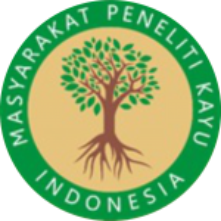Keanekaragaman Dan Pola Sebaran Spesies Tumbuhan Asing Invasif Di Kawasan Cagar Alam Durian Luncuk II
Diversity and Distribution Patterns of Invasive Alien Plant Species in the Durian Luncuk II Nature Reserve
DOI:
https://doi.org/10.22437/jurnalsilvatropika.v9i1.43966Keywords:
Durian Luncuk II Nature Reserve, biodiversity, distribution pattern, invasive alien speciesAbstract
ABSTRACT
The plant diversity in Indonesia is often disrupted by the introduction of invasive alien species (IAS), which can have negative impacts on ecosystems and biodiversity. Invasive alien species possess the ability to grow rapidly and compete with native plants, threatening biodiversity in protected areas. This study aims to identify invasive plant species in the Durian Luncuk II Nature Reserve and analyze their impact on the local ecosystem. The research employs a combination of transect and plot line methods with a sampling rate of 2% of the total area. Data collected include plant species, individual counts, habitus, and vegetation analysis using relative density, relative frequency, and the Importance Value Index (IVI). The results show 16 invasive plant species, with Clidemia hirta having the highest IVI (44,21%), dominating nearly all observation plots. The distribution pattern of invasive species is predominantly clumped. These findings indicate that invasive species, particularly C. hirta, have the potential to threaten biodiversity and the integrity of ecosystems in the Durian Luncuk II Nature Reserve, necessitating control and rehabilitation measures to maintain ecosystem balance.
Keywords: Durian Luncuk II Nature Reserve, biodiversity, distribution pattern, invasive alien species
ABSTRAK
Keanekaragaman tumbuhan di Indonesia sering terganggu oleh masuknya spesies tumbuhan asing invasif (IAS) yang dapat menyebabkan dampak negatif terhadap ekosistem dan keanekaragaman hayati. Tumbuhan asing invasif memiliki kemampuan untuk tumbuh cepat, bersaing dengan tumbuhan lokal. Ancaman dari tumbuhan invasif merupakan salah satu faktor utama penyebab kerusakan biodiversitas di Indonesia, termasuk dalam kawasan cagar alam. Penelitian ini bertujuan untuk mengidentifikasi spesies tumbuhan asing invasif di Kawasan Cagar Alam Durian Luncuk II serta menganalisis dampaknya terhadap ekosistem lokal. Metode yang digunakan dalam penelitian ini adalah kombinasi metode jalur dan garis berpetak dengan pengambilan sampel sebesar 2% dari total luas kawasan. Data yang dikumpulkan mencakup spesies tumbuhan, jumlah individu, habitus, serta analisis vegetasi menggunakan kerapatan relatif, frekuensi relatif, dan Indeks Nilai Penting (INP). Hasil penelitian menunjukkan bahwa terdapat 16 spesies tumbuhan asing invasif, dengan Clidemia hirta memiliki INP tertinggi (44,21%), mendominasi hampir seluruh petak pengamatan. Pola sebaran spesies invasif umumnya mengelompok (clumped). Temuan ini menunjukkan bahwa spesies invasif, terutama C. hirta, berpotensi mengancam keberagaman hayati dan integritas ekosistem di Cagar Alam Durian Luncuk II, sehingga memerlukan tindakan pengendalian dan rehabilitasi untuk menjaga keseimbangan ekosistem..
Kata kunci: Cagar Alam Durian Luncuk II, keanekaragaman hayati, pola sebaran, tumbuhan asing invasif
Downloads
References
Alpert P, Bone E, Holzapfel C. 2000. Invasiveness, Invasibility and The Role of Environmental Stress In The Spread Of Non-Native Plant. Amherst (MA): Department of Biology and Organismic and Evolutionary Biology, University of Massachusetts.
Anjani D, Muliawan F, Sari DS. 2024. Kajian kerusakan ekosistem akibat dominansi spesies invasif di hutan sekunder. Jurnal Biologi Hutan Tropis. 22(1):17–25. DOI: https://doi.org/10.47235/jbht.v22i1.891
Brower JE, Zar JH. 1979. Field and Laboratory Methods for General Ecology. Dubuque (IA): Wm. C. Brown Company Publishers.
Campbell FT, Schlarbaum S, Wainger L. 2005. Ecological and Economic Impacts of Invasive Alien Species: A Framework for Understanding and Management. Washington (DC): National Invasive Species Council.
Cao L, Zhu Y, Wang L, Pan X. 2018. Allelopathic Effects of Clidemia hirta on Germination and Growth of Native Species. Allelopathy Journal. 45(1):93–104.
CBD. 2002. Guiding Principles for the Prevention, Introduction and Mitigation of Impacts of Alien Species That Threaten Ecosystems, Habitats or Species. Montreal (CA): Secretariat of the Convention on Biological Diversity.
Gibson DJ, Gibson LA. 2006. Spatial Patterns. In: Kent M, editor. Vegetation Description and Analysis: A Practical Approach. London (UK): Wiley. p. 196–234.
Hartini S, Siregar IZ, Kusmana C. 2017. Strategi pengelolaan tumbuhan invasif pada kawasan konservasi: Studi kasus Taman Nasional Gunung Ciremai. Jurnal Penelitian Kehutanan Wallacea. 6(2): 125–136. https://doi.org/10.18330/jwallacea.2017.vol6iss2pp125-136
IASP. 2005. Invasive Alien Species Programme: Strategic Framework for Managing Invasive Species. Gland (CH): IUCN Global Invasive Species Programme.
IUCN. 2009. Invasive Species and Climate Change. Gland (CH): International Union for Conservation of Nature.
IUCN. 2017. Guidelines for Invasive Species Management on Islands. Gland (CH): International Union for Conservation of Nature.
Ismaini L. 2015. Potensi alelopati Clidemia hirta terhadap perkecambahan dan pertumbuhan tanaman asli. Jurnal Biologi Tropis. 15(2):142–148.
Lestari DA, dan Siregar AZ. 2021. Pengendalian spesies tumbuhan asing invasif: studi pendekatan kebijakan dan manajemen. Jurnal Konservasi Sumber Daya Alam. 9(1): 45–54. https://doi.org/10.24198/jksda.v9i1.31847
Krebs CJ. 1972. Ecology: The Experimental Analysis of Distribution and Abundance. New York (NY): Harper and Row.
Kusuma A, Febrianti N, Satriawan B. 2018. Persebaran dan strategi penanggulangan spesies invasif pada kawasan penyangga taman nasional. Jurnal Ekosistem dan Kehutanan. 6(2):98–107.
Master LL. 2015. Invasive species impact on biodiversity: The Overlooked Dimension. Biodiversity and Conservation. 24(8):1963–1975.
Maulana H, Yusuf MR. 2022. Pengaruh invasi tumbuhan eksotik terhadap regenerasi spesies asli di kawasan pasca tambang. Jurnal Lingkungan Alam. 11(1):33–41.
Nugraha MY, Raharjo SE, Fitriana E. 2019. Restorasi ekosistem untuk mengendalikan penyebaran spesies invasif di kawasan pasca kebakaran. Jurnal Hutan Lestari. 7(1): 88–96.
Odum EP. 1996. Fundamentals of Ecology. 5th ed. Philadelphia (PA): Saunders College Publishing.
Purnomo H, Simangunsong BCH, Yuwono SB. 2020. Tumbuhan asing invasif dan ancaman terhadap keanekaragaman hayati di kawasan konservasi. Jurnal Biologi Tropis. 20(3): 325–334. https://doi.org/10.29303/jbt.v20i3.2505
Putri EN, Rahmawati Y, Syamsudin U. 2022. Peran masyarakat dalam pengendalian spesies invasif berbasis ekosistem. Jurnal Konservasi Tropika. 10(2):189–197
Pyšek P, Hulme PE, Simberloff D, Bacher S, Blackburn TM, Carlton JT, Richardson DM. 2018. Scientists’ warning on invasive alien species. Biological Reviews. 95(6):1511–1534.
Radiansyah R, Rauf A, Tjitrosoedirdjo SS. 2015. Pengelolaan tumbuhan asing invasif di kawasan konservasi. Jurnal Konservasi Hayati. 1(2):66–74.
Soerianegara I, Indrawan A. 2008. Ekologi Hutan Indonesia. Bogor (ID): IPB Press.
Suroso A, Setiawan A, Herlina N. 2021. Analisis kerentanan ekosistem terhadap spesies invasif di hutan tropis dataran rendah. Jurnal Biologi Tropis. 19(3):321–328.
Teo SP, Tan HTW, Turner IM. 2020. Impacts of invasive alien plant species on tropical forest structure and diversity. Forest Ecology and Management. 456:117682.
Tjitrosoedirdjo SS, Adiwibowo S, Witjaksono D. 2016. Status Tumbuhan Introduksi dan Invasif di Indonesia. Jakarta (ID): LIPI Press.
Tjitrosoedirdjo SS. 2017. Strategi pengelolaan tumbuhan asing invasif di Indonesia. Jurnal Biologi Indonesia. 13(2):117–132.
Wahyuni R, Handayani R, Pratama D. 2020. Dampak tumbuhan invasif terhadap biodiversitas di kawasan konservasi. Jurnal Konservasi Alam Indonesia. 8(2):99–108.
Wardani S, Prasetyo LB, Duryat D. 2022. Pendekatan pengendalian biologis terhadap tumbuhan asing invasif berbasis ekologi. Jurnal Ekologi Tropika. 26(1): 15–23. https://doi.org/10.24843/JET.2022.v26.i01.p02
Weber E. 2003. Invasive Plant Species of the World: A Reference Guide to Environmental Weeds. Wallingford (UK): CABI Publishing.
Wittenberg R, Cock MJW. 2001. Invasive Alien Species: A Toolkit of Best Prevention and Management Practices. Wallingford (UK): CAB International.
Zimdahl RL. 2007. Fundamentals of Weed Science. 3rd ed. San Diego (CA): Academic Press.
Downloads
Published
How to Cite
Issue
Section
License
Copyright (c) 2025 Bakti Mandala, Nursanti, Hari Darmawan

This work is licensed under a Creative Commons Attribution 4.0 International License.
















